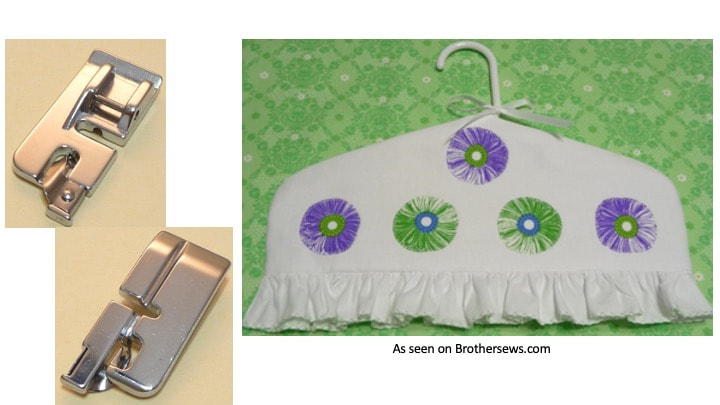I had a virtual meet-up with Beth Sweet, owner of Quilts and Lace, as customers and friends shopped and celebrated in her store on April 1st, 2021! If you missed the live show, you can catch a replay HERE on Facebook. Below you'll find a re-cap of many of the tips I shared for using eight different sewing machines accessories. I matched up each accessory with a blue hyperlink link to a project or set of instructions. Simply click the links to learn more about each accessory. Enjoy!
SA280
As seen on It's Sew Easy TV show 1411-2. You can watch this show on my YouTube channel HERE.
This accessory is specifically made for certain machine models. I can count a combination of about ten past and current Brother models compatible with the felting attachment. Brother dealers have the most updated information with a list of models that work with this attachment.
Felting is really a very simple process. You may have seen the tools used to create felting by hand. Machine felting is much faster and doesn't require the muscles it takes to felt using the hand method.
For felting, fibers, yarns, and materials are pushed into a base as you layer them and move across the base as if you were darning or doing free motion stitchery.
Here is a list of suitable fabrics for the base:
- Craft Felt
- Wool Felt
- Denim
- Fleece
- Silk Dupioni
- Lutradur
- Non-tear Stabilizers
For more information, you'll find a detailed video presented by Quilts and Lace expert instructor Aira Kekäle on their Facebook page HERE.
Th bottom of this foot is designed to push against the feed dogs on the machine. When combined with an increased upper tension and a stitch length of 3-4, light weight fabrics are evenly gathered with this foot. If you'd like to gather one layer while sewing to a second, un-gathered layer, simply place layer to be gathered against the feed dogs and guide flat, un-gathered layer into the slot on the foot. Note that these gathers are not adjustable when finished.
Tip: Keep your index finger behind the foot as the fabric strip advances to push in slightly more gathers.
Materials like the PVC used for the apron have a vinyl coating and this slick foot will glide and roll right across the fabric without sticking. It's ideal for topstitching, or any time you are sewing against a surface that clings to the standard foot.
Tips: For sticky fabrics that must be sewn against the feed dogs, layer with a piece of tear away stabilizer for smooth sewing, and carefully tear away when finished. Consider making your own vinyl coated fabric using Therm-o-Web Iron-on clear adhesive vinyl.
I used this foot to anchor the layers of my black and white pieced placemat, sewing each square where the seams are joined together. By the way, the placemat itself is made from cut up napkins, decorated with rows of fancy stitches. I wanted my coordinating napkins to match so I bought extra napkins and used them as fabric.
This is a "must have" foot for anyone who does quilting or patchwork.
Tip: Most of the time this foot is used with a center needle straight stitch, but you can move the needle to a different position to sew a specific distance from the seamline.
Watch the entire show HERE on my YouTube channel.
See more about the edge going foot HERE on It's Sew Easy TV show 905-3.
Notice the dual channels on the bottom of the foot. These channels come in handy when you want to sew your piping on the right or left side as you position the layers at the machine.
SA133
I like to use this blind hem foot as adjustable edge guide for topstitching and edge stitching. You can't see it in the photo, but this foot helped me stitch the tote very close to the finished edge, giving a fine finish and keeping the lining layer tucked inside the tote bag.
I also used this foot to stitch the self-fabric fish on the double layer flannel baby blanket shown below:
SA149
Check the settings shown below and you'll see that the upper tension is increased to pull the zig zag over the rolled edge. The resulting hem has a scalloped appearance.
















 RSS Feed
RSS Feed